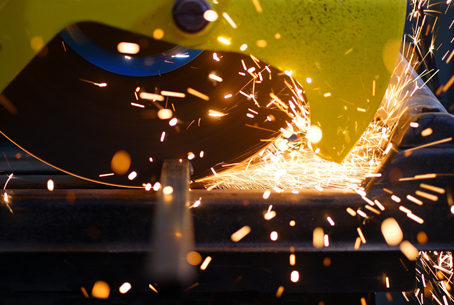Welding is one of the important manufacturing processes employed in various fabrication units. Different types of metals are considered for welding. Like any other manufacturing process, it is also conducted using a variety of tools to ensure precision. However, several steps are taken before the actual welding process to ensure its appropriateness. Preparation of metal is one of the important steps in metal welding because the best welds are produced from cleaner metals. There are several metal welding tips being discussed over the years; however, metal cleaning tips are rarely discussed. This post gives away some easy-to-follow metal cleaning tips.

How to clean metal before welding?
Preparation of metal depends on the type of welding that you plan to do. There are two types of welding processes— metal inert gas (MIG) and tungsten inert gas (TIG) welding. Both these techniques make use of an electric arc; however, they differ in their approach. In MIG welding, the metal sheets are not completely cleaned. On the other hand, in TIG welding, the metal parts are properly cleaned before they are welded. The following easy-to-follow tips will help prepare metals for either type of welding:
- Use a Wire Brush to Remove Thick Impurities: This is one of the easiest methods of metal preparation. A wire brush is a basic tool used to remove thick impurities on any metal piece. These wire brushes are easily available in most welding facilities because they are used to remove flux from the finished workpiece. Be sure to use specific wire brushes for different metals. For instance, you need to use a steel wire brush to remove impurities from a piece of aluminum.
- Use an Angle Grinder and a Flap Disc: The sheet can be prepared for TIG or MIG welding using an angle grinder and a flap disc. Any coating existing on a thick sheet can be easily removed using a flap disc. However, this tool is not recommended for thin metal sheets because it may remove lots of other materials. The coating removal is followed by cleaning using acetone. This technique works brilliantly for chassis parts that require heavy welding.
- Use Plasma Cutter for Making Frequent Cuts on Thick Metal: Many welding projects require cutting thick metals in desired angles prior to welding. This can be easily done using a plasma cutter. These cutters may demand a high upfront investment; however, they are beneficial in several ways. Plasma cutters help you save on fuel costs, preheating times, as well as make fast cuts on thick metals with small kerfs. These cutters are an ideal choice in welding facilities that want to save on their material costs as well as employee times.
- Use Abrasive Blasting for Rusty Materials: If the metal sheet is rusty, and cannot be cleaned with any of the above-discussed methods then it is perfect to pursue abrasive blasting. This technique helps remove impurities from the metal, after which it needs to be cleaned using acetone to remove the leftover chemical contaminants. One of the main challenges faced by this type of metal preparation is that an abrasive surface may trap pieces of metal, which may later initiate corrosion of the metal part. Thus, it is always recommended to avoid this cleaning method for aluminum because it is sensitive to contaminants that may remain over the metal sheet even after cleaning it with acetone.
FAQ (Frequently Asked Questions)
Why is proper metal preparation important before welding?
Proper metal preparation is crucial for achieving strong and durable welds. It helps ensure good fusion, minimizes defects, improves the quality of the weld joint, and enhances the overall structural integrity of the welded component.
Why is it important to remove surface contaminants?
Surface contaminants can adversely affect the welding process and result in weak welds or defects. They can prevent proper fusion, cause porosity, create discontinuities, or weaken the overall weld strength.
What is surface profiling and why is it necessary?
Surface profiling involves preparing the metal surface to provide better adhesion to the weld. This can be achieved through techniques such as grinding, sanding, or using specialized tools to create grooves or roughen the surface. Surface profiling improves the weld’s mechanical bond and reduces the chances of failure.
When is preheating necessary before welding?
Preheating is often required when welding certain materials, such as thick sections, high-carbon steels, or materials with high thermal conductivity. Preheating helps prevent cracking, minimizes residual stresses, and improves weldability in challenging situations.
How can one determine the need for preheating?
The need for preheating depends on factors like material type, thickness, welding process, and welding codes or specifications. Refer to material-specific guidelines, consult with experts, or follow welding procedure specifications (WPS) to determine if preheating is necessary.
Can I weld without preparing the metal surface?
While it is technically possible to attempt welding without proper metal preparation, it is not recommended. Inadequate preparation can lead to weak welds, an increased risk of defects, and compromised structural integrity, resulting in weld failure or performance issues.
In addition to these cleaning tools, you may also require other tools and equipment for the metal welding processes. They include welding tables, welding cart, welding clamps, welding helmets, and so on. It is important that you source these essentials from a trusted manufacturer like Woodward Fab. The company also provides a wide range of plasma cutters, weld shavers, MIG welders, and so on.
Related Post:
-
The Foundation of Flawless Drilling: How to Set Up Your Drill Press
-
Why Welding Helmets are Essential for Metalworkers
-
How Metal Fabricators Can Optimize Plasma Cut Quality?
-
Know About 5 Main Types of Welding Processes
-
Plasma Cutting Machine – Its Working and Uses